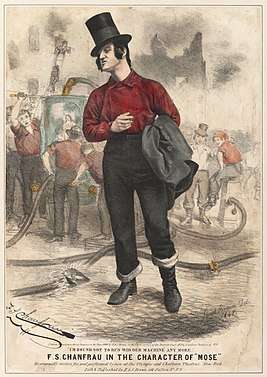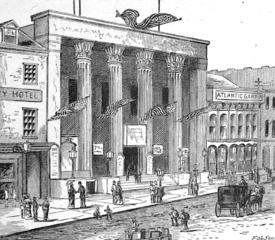Bowery B'hoy
The New Yorker vernacular pronunciation of Bowery Boys was Bowery B’hoys referring to working-class single men living mostly along the Bowery in New York City in the early 19th century. Notorious for their rowdy behavior and bright clothes, these men participated actively in theatre audiences during their time away from work and their living wards.
Bowery Boys | |
 Moses Humphrey a Bowery grocer was the inspiration for Mose the fireman, the quintessential Bowery B'hoy folk hero | |
| Named after | The Bowery |
|---|---|
| Location |
|
Volunteers | Firemen |


History
In the Antebellum Period, the population of single working men living in lower Manhattan increased significantly. These young men were drawn to the city by rising wages for laborers, brought about by growing technology and industrialization that followed the War of 1812. Typically firemen or mechanics, b'hoys spent their free time in the theaters and bars that surrounded their living wards around the Bowery.[1] The Bowery B'hoys were also known for their gang activity, engaging in fights and riots with members of opposing gangs such as the Dead Rabbits.[2]
Writer James Dabney McCabe observed of the Bowery B'hoy in 1872:
“You might see him ‘strutting along like a king’ with his breeches stuck in his boots, his coat on his arm, his flaming red shirt tied at the collar with a cravat such as could be seen nowhere else...None so ready as he for a fight, none so quick to resent the intrusion of a respectable man into his haunts.”[3]
The term B'hoy was also widely used to describe a young man of the working-class who enjoyed drinking, seeking out adventure, and finding fun.[4] Bowery B'hoys had a distaste for aristocracy and a love of independence, bravery, and loyalty.[5]
Appearance
Appearance was of great importance to Bowery B'hoys, who dressed for both flair and convenience. A typical Bowery B'hoy wore:
“[a] black silk hat, smoothly brushed, sitting precisely upon the top of his head, hair well oiled, and lying closely to the skin, long in front, short behind, cravat a-la sailor, with the shirt collar turned over it, vest of fancy silk, large flowers, black frock coat, no jewelry, except in a few instances, where the insignia of the engine company to which the wearer belongs, as a breastpin, black pants, one or two years behind the fashion, heavy boots, and a cigar about half smoked, in the left corner of his mouth, as nearly perpendicular as it is possible to be got. He has a peculiar swing, not exactly a swagger, to his walk, but a swing, which nobody but a Bowery boy can imitate.”[6]
George Foster, a travel writer, wrote in 1850:
“Who are the b’hoys and g’hals of New York?...sometimes a stout clerk in a jobbing-house, oftener a junior partner at a wholesale grocery, and still more frequently a respectable young butcher with big arms and broad shoulders, in a blue coat with a silk hat and a crape wound about its base, and who is known familiarly as a ‘Bowery Boy!'”[7]
Theater audiences
Higher wages brought higher standards of living for working-class citizens, which provided them both social mobility and the ability to indulge in entertainment.[8] As Bowery B'hoys and similar characters made up a significant portion of theater audiences, theaters such as the Bowery Theater and the Chatham Theatre created their playbills to suit the audience's interests. Plays were done alongside other acts, such as popular songs and dances, Minstrelsy, and other sketches or demonstrations. Even Shakespeare's works, which gained popularity at the time, were altered to include colloquial language and popular music.[9]
Rowdiness
Rowdy Bowery B'hoy audiences mostly sat in the theater's pit, and often requested that songs, dances, and scenes be repeated multiple times or added impromptu to the performance,[10] even taking over the stage and participating in the drama at times.[11] Bowery B'hoys and other audience members threw food and booed or hissed performers they didn't enjoy.[12]
Frances Trollope described similar behavior in Cincinnati audiences at the time, narrating,
"the spitting was incessant; and the mixed smell of onions and whiskey was enough to make one feel even the Drakes acting dearly bought...the heels thrown higher than the head, the entire rear of the person presented to the audience...and when a patriotic fit seized them, and 'Yankee Doodle' was called for, every man seemed to think his reputation as a citizen depended on the noise he made."[13]
Some found this behavior more tolerable:
“Walt Whitman warmly recalled the Bowery Theatre around the year 1840, where he could look up to the first tier of boxes and see ‘the faces of the leading authors, poets, editors, of those times,’ while he sat in the pit surrounded by the ‘slang, wit, occasional shirt sleeves, and a picturesque freedom of looks and manners, with a rude, good-nature and restless movement’ of cartmen, butchers, firemen, and mechanics.”[14]
Rioting
The Bowery B'hoys, among other groups, participated in the Astor Place Riots of 1849, which were fueled by class tensions in New York City as well as a drawn-out feud between actors Edwin Forrest and William Macready.[15]
Theatrical representation
Benjamin Baker's play A Glance at New York, written in 1848, created popular depictions of a Bowery B'hoy and G'hal. Their sayings and the names of the characters, Mose and Liza, were picked up and used popularly to refer to b'hoys and g'hals outside of the production. Even travel writers used these characterizations to describe Bowery B'hoys and G'hals to tourists and readers abroad.[16]
Mose
Based on grocer Moses Humphrey,[17] this character was exemplary of a Bowery B'hoy of New York. He discusses theatre with Lize, his g'hal, goes on a fire call, and shows his heart when he's left with an orphaned baby by saying, "The fire boys may be a little rough outside, but they're all right."[18] Written phonetically in the b'hoys' typical accent, Mose's dialogue includes sayings that were picked up by audience members and used in daily life. As described by the New York Herald, "the lithographers are multiplying his likeness throughout the city. The boys in the street have caught his sayings.."[19] Throughout the play, Mose is ready to fight anyone who might oppose him or his companions. The play ends with an act of bravery on his part, as he leaves to help a fellow fireman, Sykesy, in a fight.
Lize
The Bowery G'hal was depicted in this play as Eliza Stebbins, or "Lize". George G. Foster writes on the character of Lize: "The g'hal is as independent in her tastes and habits as Mose himself. Her very walk has a swing of miscief and defiance in it, and the tones of her voice are loud, hearty, and free." In a bonnet and mismatching styles, her outfit fits the g’hal sensibility to go against the current fashions of respectable society.[20]
Reception
The characters of Mose and Lize were revisited by other playwrights and writers, including Ned Buntline in his story, The Mysteries and Miseries of New York.
Travel writer George G. Foster wrote of the play: "With the exception of the single drama which Mr. Chanfrau, slight as is its plot and meager and commonplace as are its incidents, has been able by the force of his genius to confer a new character upon the stage, nothing has been adequately done to begin imparting to our literature the original and rich wealth lying latent in the life and history of Mose and Lize."[21]
External links
See also
References
- Butsch, Richard (2000). The Making of American Audiences: From Stage to Television , 1750-1990. United States of America: Cambridge University Press. pp. 45–47.
- Anbinder, Tyler (2001). Five Points: The 19th-century New York City Neighborhood that Invented Tap. New York, NY: The Free Press. pp. 269–270.
- McCabe, James Dabney (1872). Lights and Shadows of New York Life: Or, The Sights and Sensations of the Great City. A Work Descriptive of the City of New York in All Its Various Phases. New York, NY: National Publishing Company. p. 188.
- Anbinder, Tyler (2001). Five Points: The 19th-century New York City Neighborhood that Invented Tap. New York, NY: The Free Press. p. 178.
- Foster, George G. (1850). New York by Gas-light: With Here and There a Streak of Sunshine. New York, NY: Dewitt & Davenport. pp. 101–109.
- Anbinder, Tyler (2001). Five Points: The 19th-century New York City Neighborhood that Invented Tap. New York, NY: The Free Press. p. 178.
- Anbinder, Tyler (2001). Five Points: The 19th-century New York City Neighborhood that Invented Tap. New York, NY: The Free Press. p. 180.
- Bank, Rosemarie K. (28 January 1997). Theatre Culture in America, 1825-1860. United States of America: Cambridge University Press. p. 88.
- Levine, Lawrence W. (1988). Highbrow/Lowbrow. Cambridge, MA: Harvard University Press. pp. 14–22.
- Butsch, Richard (2000). The Making of American Audiences: From Stage to Television , 1750-1990. United States of America: Cambridge University Press. pp. 50–51.
- Levine, Lawrence W. (1988). Highbrow/Lowbrow. Cambridge, MA: Harvard University Press. p. 29.
- Butsch, Richard (2000). The Making of American Audiences: From Stage to Television , 1750-1990. United States of America: Cambridge University Press. pp. 50–51.
- Trollope, Frances (1832). Domestic Manners of the Americans (4 ed.). New York, NY: Whittaker, Treacher, & Co. p. 116. Retrieved 30 June 2016.
- Levine, Lawrence W. (1988). Highbrow/Lowbrow. Cambridge, MA: Harvard University Press. p. 25.
- Levine, Lawrence W. (1988). Highbrow/Lowbrow. Cambridge, MA: Harvard University Press. p. 63.
- Foster, George G. (1850). New York by Gas-light: With Here and There a Streak of Sunshine. New York, NY: Dewitt & Davenport. pp. 101–109.
- Anbinder, Tyler (2001). Five Points: The 19th-century New York City Neighborhood that Invented Tap. New York, NY: The Free Press. p. 181.
- Baker, Benjamin (1848). A Glance at New York. New York, NY.
- Bank, Rosemarie K. (28 January 1997). Theatre Culture in America, 1825-1860. United States of America: Cambridge University Press. pp. 86–88.
- Foster, George G. (1850). New York by Gas-light: With Here and There a Streak of Sunshine. New York, NY: Dewitt & Davenport. p. 107.
- Foster, George G. (1850). New York by Gas-light: With Here and There a Streak of Sunshine. New York, NY: Dewitt & Davenport. p. 109.